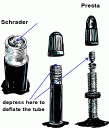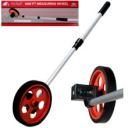LiveableStreets Alliance
Posted by @teeheehee on 3rd February 2008
![]()
This past Wednesday my rear tire went flat on the way to a LiveableStreets Alliance lecture. My innertube needed to be replaced (the presta valve tip broke off) but the lecture lightened my mood with some interesting information on how roads are engineered.
Backtracking for just a moment, I have had some brushes with LiveableStreets folks before at some other bike events. The group seems pretty solid despite their small size, dedicating themselves to presenting a fresh vision of street design engineered to meet human needs as much as motor vehicular ones. Basically, they’re working to change Boston.
The talk was entitled “Dirty Little Engineering Secrets Revealed,” and it was a powerpoint presentation given by former LiveableStreets Alliance co-founder and president Jeffrey Rosenblum. (Jeff now works for the City of Cambridge, helping their street planning.)
The talk spanned elements of psychology, engineering and design. The dirty secrets revealed were completely expected: there was a whole generation of engineering that devoted itself to the car and that is reflected in street design. This extends into the urban areas and the purpose of the street as a functioning place of commerce and burgeoning life has been replaced with one of traffic and single-minded transport.
When a street is designed there are studies done, stages of planning and review, lots of referencing to standards guides, and usually after all of that is there any public involvement. (Then, of course the street is constructed with whatever variance, no construction job ever goes 100% to plan.)
The studies are generally car-centric. Traffic numbers, connections, types of vehicles and their purposes, types of streets connected, etc. The result of a study is a report a few inches thick. How much of that for bikes? Nil.
The street gets planned following guidelines. The guidelines used were printed with some degree of flexibility which in practice is never used. When challenged why lane widths can’t be made more narrow to accommodate a bike lane they often reference the Green Book, but neglect the flexibility it allows for.
LiveableStreets works to draw attention to that flexibility factor. The current generation of engineers are still following the idea that streets need to be designed to achieve maximum throughput, with multi-lane highways often considered the pinnacle. In urban arenas this does not make sense. The next generation of engineers may have a more modern view but it will take a while for their designs to become commonplace. Political pressure and general public knowledge can help to advance this progress.
Bikes aren’t the only things that lose out to the current models of street design. Pedestrians and anyone with a permanent or temporary handicap are often considered only in the later design revisions. Engineers understand that at any one time a certain percentage of the population will have their mobility hindered and may require more time for crossing, ramps, adequate sidewalk conditions for wheels, and usually as short of a distance between entering and exiting the road as possible. That doesn’t mean design works all of this in all the time.
Highlighting the lapse in thinking with pedestrians in mind was a series of photos of the Longfellow Bridge. On one end there are no crosswalks to get someone walking from one area to the sidewalk that spans the bridge. The sidewalk itself is less than the normal width, and is peppered with obstructions. One argument states there aren’t enough pedestrians using the bridge to warrant improving the sidewalks. This is a backwards argument – if it was a better medium there would be more usage. Realistically the issue here is the same issue with any redevelopment: money.
Along with more flexible engineering there was also an example of a more radical approach which plays much more with social engineering aspects: naked streets (in large part due to late Hans Monderman. The idea here being that you should treat motorists like adults, they’ll know how to react with people walking all around them even with no signs regulating them to be courteous and yield. Intersections with no signs, which makes motorists behave differently. The result: rational decisions are made by all street users.
There was more in the talk and the discussion that followed. Time was up and I was left wanting more so I hope there will be other presentations in the future. The more we know about the limitations, the more we can maneuver within them.
Posted in bike friendly, traffic | 2 Comments »



